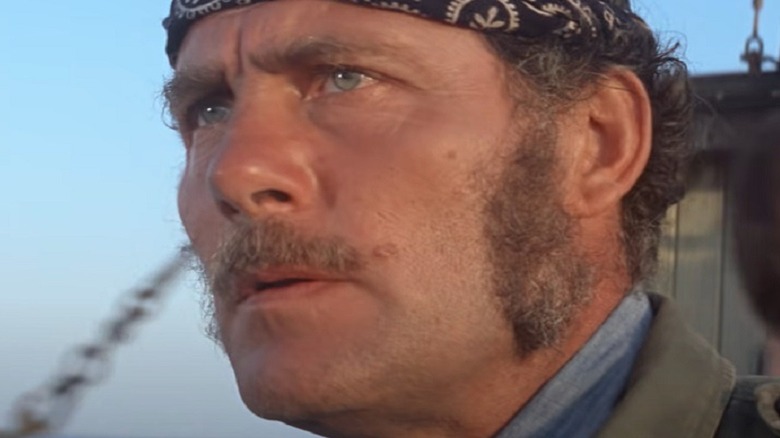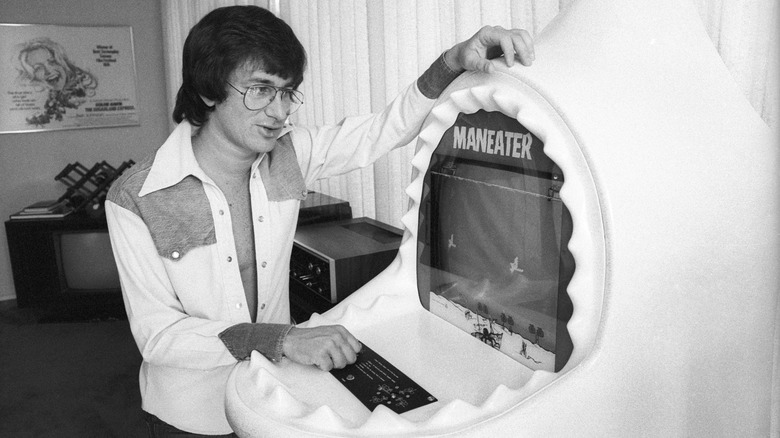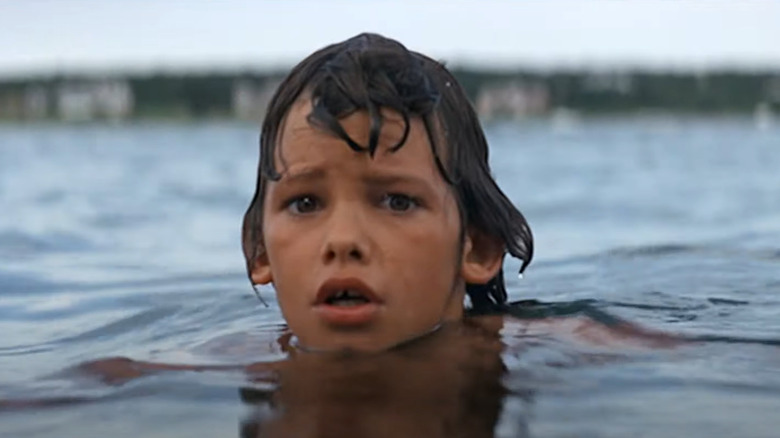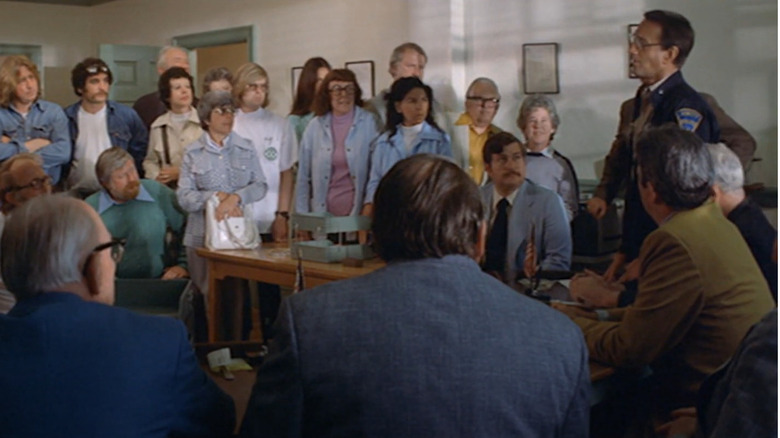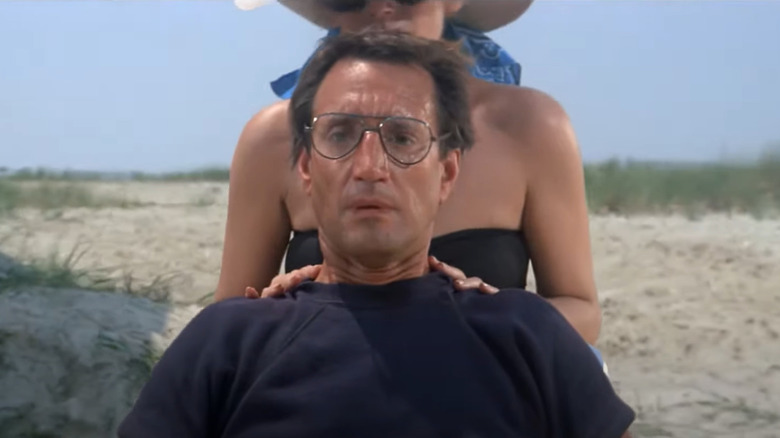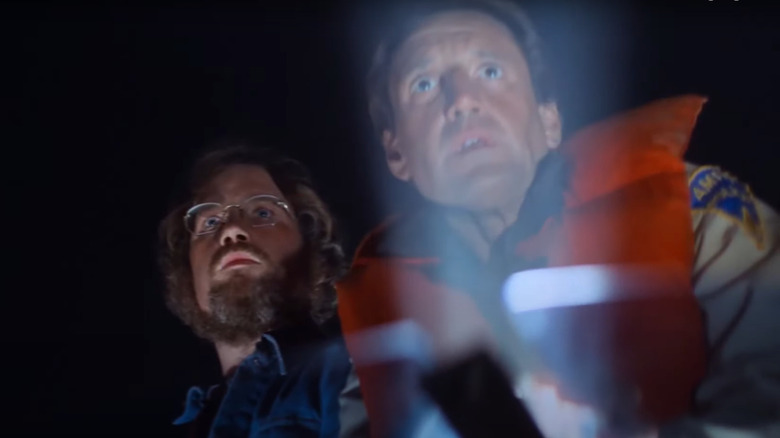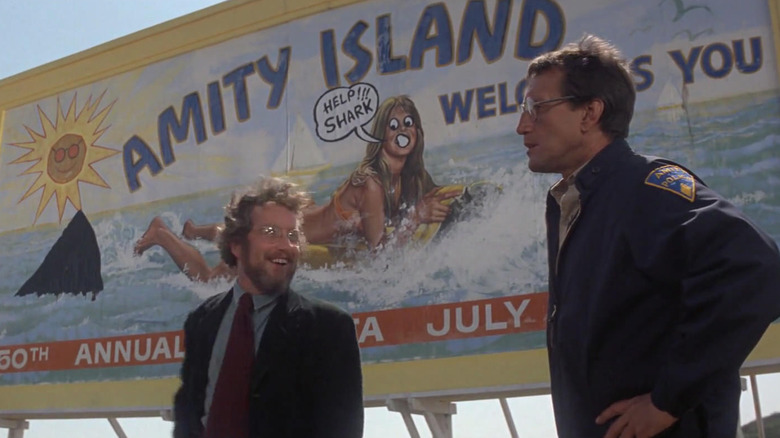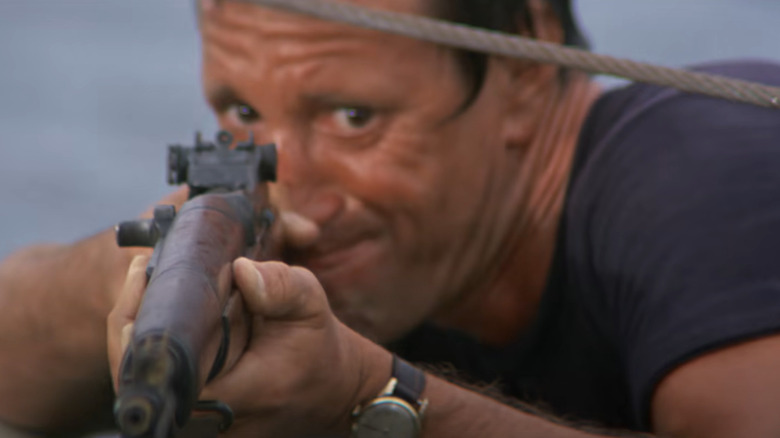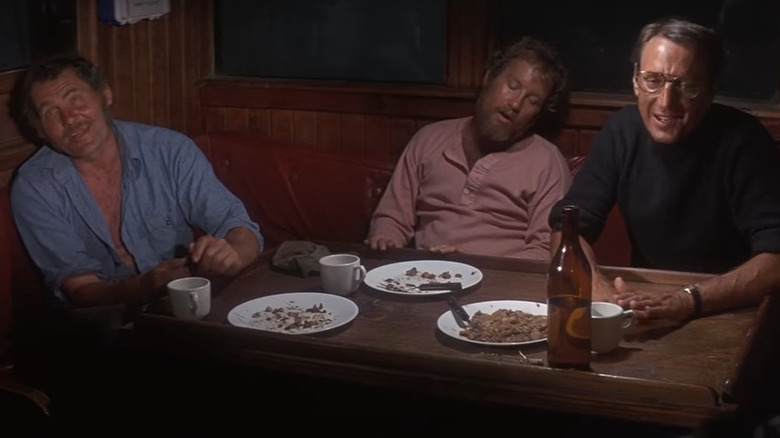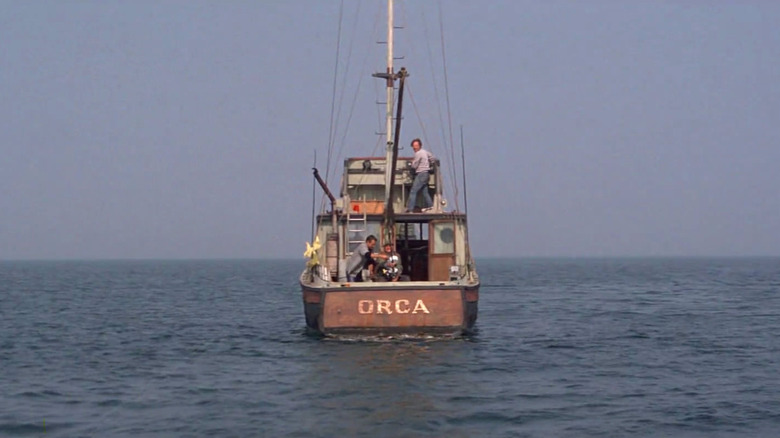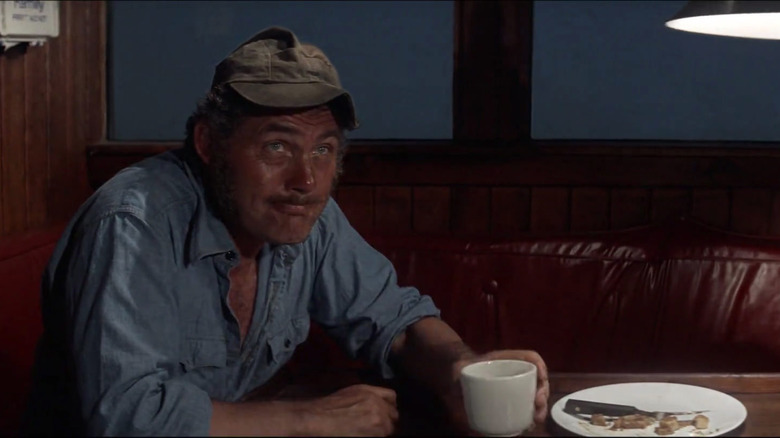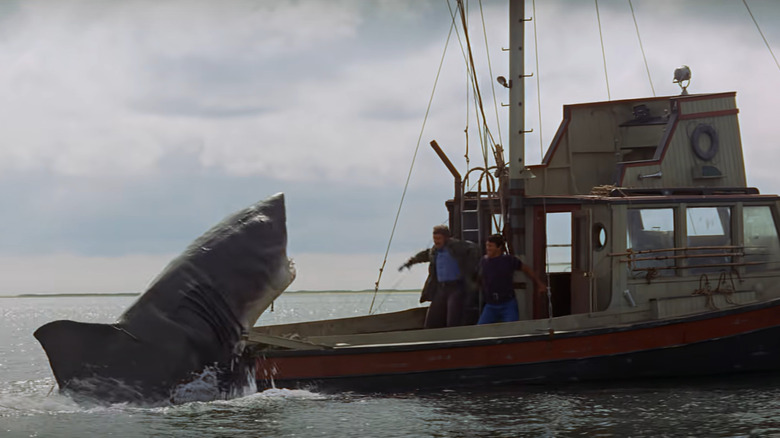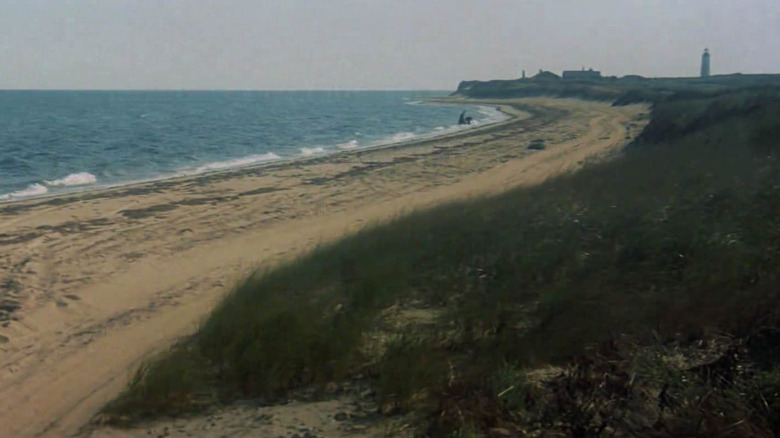What It Was Really Like To See Jaws In 1975
Maybe you grew up watching "Jaws" every summer. Maybe you saw it once in your childhood and vowed to never see it again after enduring nightmares. Maybe you've never seen it at all but know its evocative music (composed by the legendary John Williams), often mimicked or even sampled in other films and television shows. Perhaps you even have memories of a giant shark attacking your ride at Universal Studios during a family vacation to Hollywood or Orlando.
Whatever your level of familiarity with "Jaws," Steven Spielberg's classic shark attack movie, the film is so integrated into the pop culture consciousness that it's hard to imagine a time when it was new. But when the movie debuted in summer 1975, the tropes of "Jaws" weren't tropes — they were first-of-their-kind experiments. The movie's story wasn't iconic, it was unknown. So what was it really like to see "Jaws" in 1975? Let's find out.
Jaws was like an Alfred Hitchcock movie
Today, if you hear Steven Spielberg is attached to a film, you automatically know what to expect from the project in question. That kind of news paints a picture in your mind and elevates your interest in the movie based on Spielberg's signature style of direction, which we've seen play out across decades and genres.
However, if we're not counting TV movies like "Duel," "Jaws" was only the second full-length film Steven Spielberg had directed. He wasn't a household name yet. With just "The Sugarland Express" under his theatrical belt, critics and audiences wouldn't have been able to compare and contrast his movies or study them in great detail. This is unlike today, when we can chart his career and attempt to define what makes him unique.
As such, when "Jaws" hit theaters in 1975, audiences sought an established director they could compare Spielberg's work to. In the 2019 CNN docuseries "The Movies," Deadline Hollywood critic Pete Hammond pointed toward a director who was a household name at the time — one who Spielberg might've reminded audiences of. "He made this like the kind of shark movie that Alfred Hitchcock might have made," Hammond remarked.
From "Psycho" to "The Birds," Hitchcock's well-known filmography was the stuff of nightmares (in the best way possible) and certainly not for the faint of heart. In 1975, his was the perfect directorial style to use as a frame of reference when watching a town under siege by a very hungry shark.
It was as frightening as The Exorcist
In 1975, audiences would've definitely been familiar with "The Exorcist," a horror movie released two years earlier that told a tale of demonic possession. In other words, the textbook definition of a scary movie was on everyone's mind, and quite a few people compared William Friedkin's infamous classic to the newly released "Jaws." In his 1975 review of Spielberg's flick, famed movie critic Roger Ebert wrote, "It's a film that's as frightening as 'The Exorcist,' and yet it's a nicer kind of fright, somehow more fun because we're being scared by an outdoor-adventure saga instead of by a brimstone-and-vomit devil." Oh, well as long as it's more fun than a brimstone-and-vomit devil, why didn't you say so?
Public word-of-mouth wanted to make it clear what audiences were getting themselves into when they went to see "Jaws." As the podcast "The Movie Bin" points out, there was no such thing as a PG-13 rating when "Jaws" debuted. Its violence, while foreboding, wasn't graphic enough to necessitate an R rating, and so it wound up rated PG — a benchmark that by today's standards is decidedly more family friendly than "Jaws" was ever going to be. Critics like Ebert using "The Exorcist" as a comparison sounded an alarm loud and clear: "Jaws" was s-c-a-r-y.
It was a shared experience
Anyone who saw "Avengers: Endgame" its opening week in theaters can tell you that movies have the power to unite strangers and elicit excitement. If an audience is invested enough in the story, their vocal response can make moviegoing a truly special shared experience. Audiences in 1975 weren't cheering on superheroes, though. They were screaming in terror. "Jaws" producer Richard Zanuck recalled to The New York Times, "People were ripping out the seats. The place went crazy."
A large portion of "Jaws" plays the long game. A general aura of fear is present in scenes much more often than actual jump scares or action-related violence. Still, there are a few moments when the shark's doll-like eyes and insatiable appetite lead to downright terrifying cinema. It was all part of Spielberg's master plan. He studied test screenings and made slight adjustments as needed to optimize those tense sequences for maximum scream factor.
The marketing machine was huge
Many aspects of a movie release are so commonplace today that we hardly think twice about them. If a new film is slated to debut, especially during the summer and especially from a major studio like Universal, audiences can expect a huge marketing campaign ahead of the film's release. That wasn't necessarily the case in 1975.
In the docuseries "The Movies," film historian Neal Gabler explained, "'Jaws' was the first real gigantic blockbuster. Heavily advertised, [it] opened on a 'billion' screens at the same time. It became a cultural milestone immediately. It changed everything." The word "blockbuster" itself was new language.
The New York Times detailed the meteoric rise of "Jaws," which involved a huge emphasis on TV ads — a relatively new method at the time. And as the newspaper explained, "Three days before the opening, [Universal] unleashed a massive national advertising blitz, centering on the image of the shark's mouth pointing vertically up at a swimming girl." The image showed up on everything from posters to the cover of the book "Jaws" was based on. Plus, the movie was released simultaneously across the country on the same date — a "wide" release — which was a relatively uncommon practice. All in all, the final price tag of the film's marketing push was $700,000, a record for Universal.
Jaws was box-office gold
For the time, Universal sunk a huge amount of money into the promotional blitz for "Jaws" ... and it massively paid off. The film debuted in June 1975 with a domestic opening weekend of $7,061,513 in 409 theaters, for a per-theater average of $17,265. Movies today open in many, many more theaters than that, and the American dollar is worth a very different amount of money, but we can do some math to a modern blockbuster to figure out a fair comparison.
In December 2021, "Spider-Man: No Way Home" debuted with a domestic opening weekend of $260,138,569 in 4,336 theaters, for a per-theater average of $59,995. Adjusted for inflation, the opening weekend of "Jaws" would've achieved a little over $90,000 per theater today. When considering the boom that "No Way Home" provided to cineplexes, it's wild to imagine "Jaws" rocking the per-theater average even more.
In the end, "Jaws" grossed $260 million during its original 1975 theatrical run ... or $1.3 billion when adjusted for 2022 inflation. In other words, when you take that inflation into account, "Jaws" is one of the highest-grossing films of all time, beating out the likes of "Avatar" and "Avengers: Endgame." To say the least, Universal had a hit on its hands.
A pop culture phenomenon
The combination of innovative filmmaking, positive word-of-mouth, and a huge marketing push was the perfect formula for "Jaws" to become a phenomenon in its opening summer. In an ABC newscast from September 1975, anchor Peter Jennings described "Jaws" as "a movie executive's dream."
Even beyond financial success, the movie's cultural impact took over America's summer paraphernalia. That aforementioned newscast highlighted scores of official and unofficial merch, from T-shirts, socks, and bathing suits using the movie's official poster to shark jewelry. Basically, if it was shark-related, consumers couldn't get their hands on it fast enough. (Etsy is quaking.) Peter Benchley, author of the novel that inspired the movie, remarked that it was "normal commercial instinct to ride the bandwagon while the bandwagon's hot."
Steven Spielberg recalled (via The New York Times) how he walked through an ice cream shop that summer and every conversation he overheard was about the movie. In other words, "Jaws" took the nation by storm, giving a taste of what was to come from Spielberg's forthcoming career.
It created a newfound fear of sharks
In addition to the movie's massive fandom, there was another real-world cultural impact as a result of "Jaws." The movie's terrifying depiction of sharks led many beachgoers in 1975 to be more hesitant and afraid of ocean activities. The fear, if objectively irrational, is understandable to anyone who's seen the film. Play in the ocean when that thing could attack? Pass!
On July 13, 1975 — just a few weeks after "Jaws" was released — Los Angeles Times writer Robert E. Dallos (via The Poughkeepsie Journal) wrote about the "shark mania" that had come over beachgoers. Suddenly, people preferred the shore to the ocean. There was a lack of long-distance swimmers that summer. And, of course, there was an increase in shark-sighting reports. "Any fish in the water now becomes a shark," a Florida lifeguard said in the same article.
According to a 2021 study by Prof. Brianna Le Busque of the University of South Australia, the stigma still exists to a degree today, thanks to the film's lasting impact and similarly negative shark depictions it inspired in other movies. The conservation outlet Mongabay also described a "Jaws effect" coined by Christopher Neff from the University of Sydney, which is "the belief that sharks intentionally bite humans, that human-shark encounters are always fatal, and that sharks should be killed to prevent future attacks." And Prof. Le Busque found that 96% of shark representation in film and television was negative, stemming from the precedent set by "Jaws."
It was a breath of fresh air, literally
Something that seems like a given when going to the movies today is air conditioning. Believe it or not, before 1975, many theaters didn't have it. Summertime, no air, and a room packed full of people? No, thank you! That would make any moviegoing experience miserable, no matter how incredible the film was. However, HVAC companies cite "Jaws" as one of the first major motion pictures to be released when air conditioning was widely available in movie theaters, and they're proud to attribute part of the film's massive success to their installation of AC units. One can imagine that perhaps the popularity of "Jaws" was aided by moviegoers hoping to beat the summer heat by getting the scares on in a nice, chilled room. It's a reminder that every role is important in the movie business, even if at first glance it has nothing to do with filmmaking itself. So many different fields make the industry possible, and all work together to pull it off.
Jaws was a filmmaking masterclass
"Jaws" wasn't just an exciting movie — it was a well-made movie in director Steven Spielberg's competent hands. "Jaws" inspired many future directors as a reference point for how to tell a story and how to visually thread a narrative, as shared in a Universal featurette. For example, M. Night Shyamalan was about to turn 5 years old the summer that "Jaws" debuted. He would one day direct such influential thrillers as "Signs" and "The Sixth Sense," and he said he "aggressively pursued 'Jaws' as a way to learn from the master. I saw the light, you know? I saw 'Jaws' and [thought], 'That's the promised land. That's what you have to aim for.'"
Robert Rodriguez — the man behind "From Dusk Till Dawn," "Spy Kids," and "Desperado" — said "Jaws" left him "wanting to make movies that were larger than life." And Eli Roth — who directed the director behind horror films like "Hostel" and "The Green Inferno" — had nothing but praise for Spielberg's classic, explaining, "I think that anyone that wants to make big Hollywood blockbusters movies was certainly inspired by 'Jaws.'"
There's a lot to study in "Jaws," and whether its pupils have gone on to helm huge Hollywood films or are simply inspired by the movie in a more subtle way, Steven Spielberg is proud. In the same video, he remarked, "I'm always grateful when anybody, especially a young director, comes over to me and tells me they were in some way strangely influenced by 'Jaws.'"
There were a few stray dissenters
It turns out you can't please everybody, even with what can be widely acknowledged as a classic like "Jaws." It sits at an admirable 98% on Rotten Tomatoes, which means there were at least a few critics who weren't impressed. In 1975, film critic Charles Champlin, writing for the Los Angeles Times, called "Jaws" "a bore, awkwardly staged and lumpily written." Champlin claimed the movie had a "stubborn refusal of the key characters to come in to sharp focus," and he was especially taken aback by the horror-esque elements that Spielberg employed to scare the audience. Champlin closed by questioning "what it takes to entertain these days." One could maybe infer that he wasn't a fan of the film as a suspense thriller rather than the film itself, in which case, anything the movie attempted would not be his cup of tea, so the review might not be entirely fair. But hey, to each their own.
Jaws worked like a magic trick
Even if "Jaws" still holds up as a watchable — let alone incredible — film nearly 50 years after it debuted, technology has come a long way since 1975. If the movie were to be made today, it would likely include a heavy dosage of computer-generated imagery. If the director were to prefer a more practical approach to special effects, at the very least the shark animatronic would look a little bit better than the final version of the shark as it appeared in 1975. Today, we can pretty easily tell that most shots of the shark in "Jaws" are of a robotic figure. We're so trained by the special effects wizardry of modern filmmaking that 1975's best efforts feel archaic now.
We can look back on "Jaws" and maybe chuckle a bit at the shark's appearance, but in 1975, audiences completely bought it. Back in the day, Arthur Knight, a film critic for The Hollywood Reporter, commended the limited use of real shark footage paired with the animatronic and "masterful editing" to create an illusion in which it was "literally impossible to say for sure which one is which." Okay, so maybe today we can tell which one is which, but it's a testament to the film's effectiveness that the old tech isn't a distraction and the movie still works.
Jaws was cinematic perfection
Some commercially successful films aren't critically accepted at the time of their release and only become beloved after generations of adoration. Other films simply don't get much attention at all in their initial run and years later find a following and become something of a cult classic. Neither was the case for "Jaws."
Instead, it hit a home run in every category possible from the very beginning. In 1975, The Hollywood Reporter called it "perhaps the most perfectly constructed horror story in our time." It was acknowledged almost immediately as a standard-setter and something that the 1970s era of filmmaking would be remembered by. It was even nominated for Best Picture at the Academy Awards. How often do you know, in the moment, that movie history is being made? "Jaws" achieved that rare feat.
There are few summer movies, or even movies, period, that stack up to "Jaws" in terms of critical acclaim, audience response, and legacy. It will be inspiring future filmmakers, scaring audiences, and making waves at the movies for decades to come.
